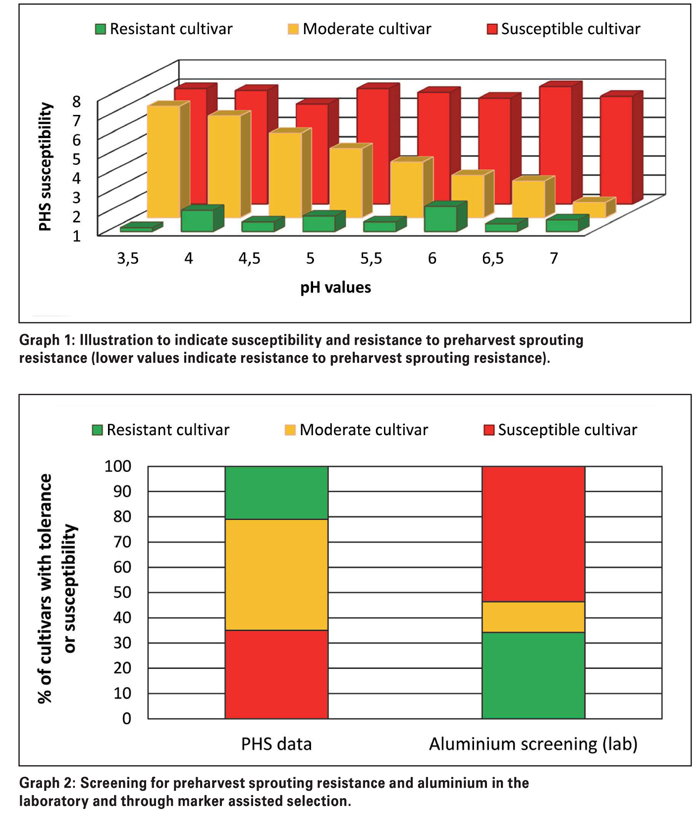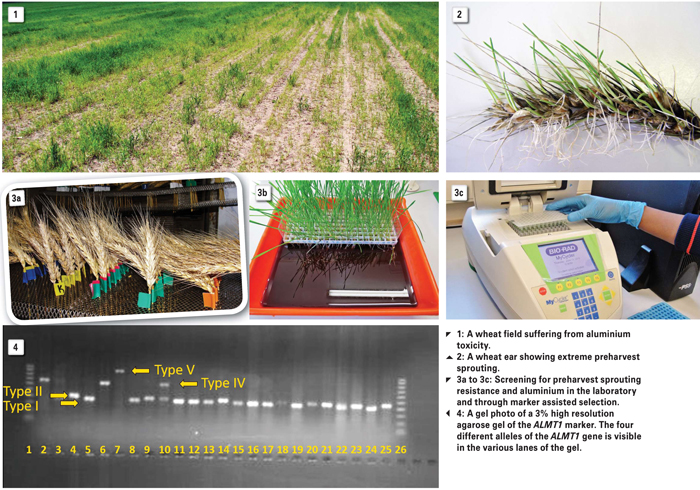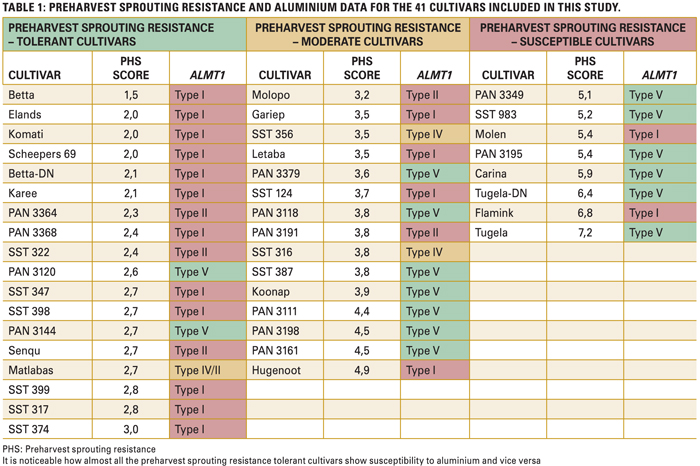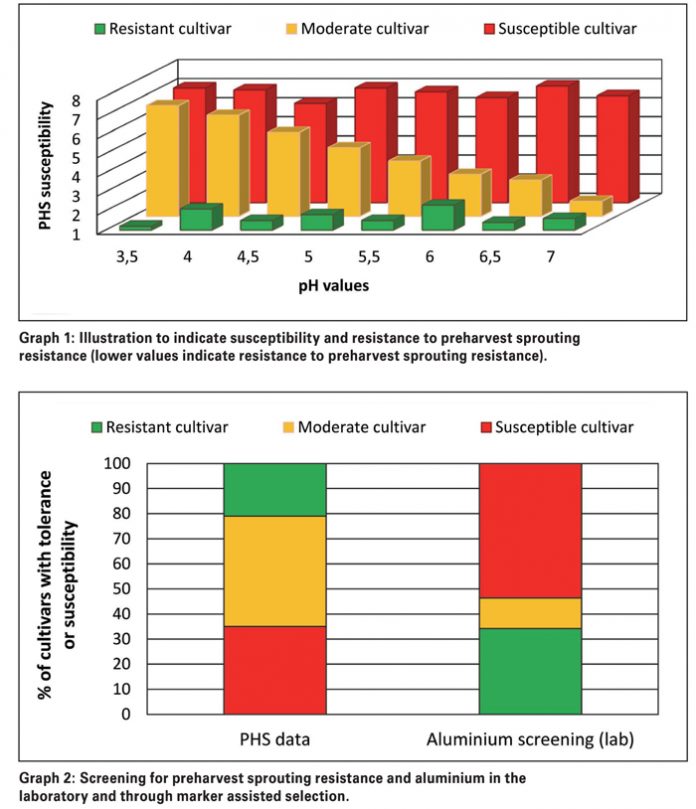November 2017
DR ANNELIE BARNARD, DR SCOTT SYDENHAM and HESTA HATTING, ARC-Small Grain, Bethlehem
Acid soils are widespread in the major wheat producing regions of South Africa. More than two thirds of the arable soils of the eastern part of South Africa – especially the Eastern Free State and KwaZulu-Natal – are affected by soil acidity. The major limiting factor to agronomic productivity in these soils is aluminium (Al) toxicity.
Preharvest sprouting is the premature germination of wheat kernels in the ear, while still attached to the mother plant. This occurs sporadically as a result of rain and prolonged moist conditions in the critical few weeks around harvest time. This leads to biological changes in the grain that lower grain yield, hectolitre mass and flour quality, resulting in huge economic implications for both producers and end-users. There is a wide range of variation in the preharvest sprouting tolerance in South African wheat cultivars, ranging from good to poor.
In a previous study it was shown that the pH of the soil had no effect on the preharvest sprouting resistance of wheat cultivars grown in those soils in the susceptible or resistance groupings (red and green groups in Graph 1). 
However, lower pH values, in other words increased soil acidity, led to higher levels of preharvest sprouting resistance susceptibility of the moderately resistance cultivars (yellow group). We also know that the moderately resistant group of cultivars is in general more prone to environmental stresses than the susceptible or resistant group.
A cultivar in this group may have a good preharvest sprouting resistance in certain years under certain conditions, while the same cultivar can show susceptibility to preharvest sprouting resistance under different conditions.
Throughout the years, various cultivar registration publications reported that lines or cultivars with good resistance to preharvest sprouting resistance have poor tolerance to aluminium in the soil and vice versa. It has also been shown that lines or cultivars with moderate aluminium tolerance usually have moderate resistance to moderate susceptibility to preharvest sprouting resistance.
We therefore tried to determine if there was indeed an association between the preharvest sprouting resistance susceptibility of wheat cultivars and their tolerance to aluminium toxicity or if this was mere coincidence.

How did we conduct the research?
A total of 41 wheat cultivars were screened for their preharvest sprouting resistance tolerance/susceptibility over a period of ten years. This screening was done in a rain simulator where the ripe wheat ears were subjected to a simulated rain treatment and scored according to the sprouting of the kernels that took place in the ears. The various cultivars were grouped into resistant, moderate or susceptible groups.
The same cultivars were screened in the laboratory for aluminium tolerance, based on the haematoxylin staining method. According to this method cultivars could be classed as tolerant (where the tip of the root was not stained, indicating successful regrowth after staining) versus susceptible (where the root tip was stained, which means that no regrowth of the root took place after staining).
In addition to the laboratory screening of aluminium tolerance, molecular markers were used to determine the presence of different forms of the aluminium tolerance gene ALMT1. These different forms confer varying levels of aluminium tolerance in each cultivar.
What did we find?
The preharvest sprouting resistance of the cultivars in the study varied from good (in 35% of the cultivars) to susceptible (in 21% of the cultivars) (Graph 2). The laboratory screening of aluminium tolerance indicated that 34% of the cultivars were tolerant and 54% of the cultivars were susceptible.
In the molecular laboratory four types of the ALMT1 gene were identified. Type I and Type II confer aluminium susceptibility, while Type V is an indication of aluminium tolerance. Type IV shows moderate tolerance to aluminium.
A very good correlation (R2 = 0,81) was observed between the laboratory screening of aluminium and the marker validation. This means that the ALMT1 marker data (Photo 4) showed similar results to the research that was conducted with the visual screening of aluminium tolerance.
In Table 1 the preharvest sprouting resistance data and the aluminium results for the wheat cultivars used in this study are shown. The cultivar Matlabas had a mixed ALMT1 genotypic profile, showing both Type II and Type IV alleles. The Type IV allele is dominant, so this means that the cultivar has a moderate tolerance to aluminium. This was also confirmed by the phenotypic screening.

The results further indicated that there is a significant negative correlation (R2 = -0,68) between the preharvest sprouting resistance characteristics of the cultivars and their aluminium tolerance or susceptibility. This means that in 94% of cultivars tested, cultivars with ‘n good preharvest sprouting resistance tolerance (preharvest sprouting resistance score lower than 3), had poor aluminium tolerance. Similarly, in 75% of the cultivars tested, cultivars with poor preharvest sprouting resistance tolerance (preharvest sprouting resistance score higher than 5), showed good aluminium tolerance.
The reason for this is still speculative. One of the explanations is the fact that the major genes responsible for preharvest sprouting resistance tolerance and aluminium tolerance are positioned on the same chromosome. This creates a competition for ‘genetic space’ which complicates the normal crossing process in breeding. The fact that these two important traits occur on the same wheat chromosome, and also at similar positions, suggests that most of the time a natural crossover event will knock each other out.
To make progress in traditional breeding programmes, thousands of lines will need to be phenotypically screened in order to try and find a line that contains both traits. Without the dedicated selection for preharvest sprouting resistance and aluminium tolerance with molecular markers, this will be very difficult, if not impossible.
Why is this important in the breeding process?
There is a significant negative correlation between preharvest sprouting resistance and aluminium sensitivity in South African wheat cultivars, which was confirmed by molecular data.
The ALMT1 data marker appears more sensitive than the laboratory aluminium testing, as a clearer distinction between moderate tolerance genotypes could be made. Until now it was not possible, or very difficult, to develop cultivars with tolerance to both preharvest sprouting resistance and aluminium toxicity.
PAN 3120 and PAN 3144 are the only cultivars with good tolerance to both parameters. The data from this study, however, can be used in future to identify germplasm that contains both good preharvest sprouting resistance and aluminium tolerance.
Why is this important to producers?
Producers should be familiar with the various characteristics of the cultivars that are commercially available. The results shown here again highlight the importance of correct and timeous liming procedures. To only rely on cultivars with tolerance to high levels of aluminium can lead to huge economic losses if crops are downgraded as a result of preharvest sprouting resistance.
Both the preharvest sprouting resistance and aluminium data are available in the annual Production guidelines for small grains. It is therefore important that producers take note of these correlations in order to make the correct cultivar choice for their specific situation.
Publication: November 2017
Section: On farm level


















